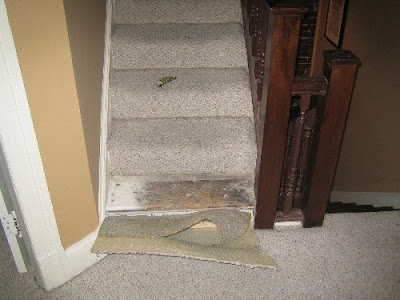As the condition of this carpet got worse and worse, we started to realize that some sort of hardwood floor was underneath and refinishing the hardwood floor to look nice was a distinct possibility.
Over the course of several months, we pulled the carpet off the stairs, pulled out tens of thousands of old carpet tacks and staples, sanded the stairs down to their original wood, and coated with Minwax Dark Walnut stain and two coats of Minwax Polyurethane for floors. The stairs looked good - certainly better than the berber - so we decided to take the plunge and remove the second floor carpet entirely.

Besides being covered in thousands and thousands of staples and white paint overspray, about 30 linear feet of the floor boards had been worn through, water damaged, or otherwise splintered beyond the ability of wood filler to fix. Several web articles suggested that we could cut out the damaged boards and insert replacements without needing to rebuild the entire floor - but 1906 floorboards are an odd size that is apparently no longer made today.
Fortunately, Community Forklift - a nonprofit salvage yard for building materials - is located only about 15 minutes away, and they had essentially the exact same pine boards as our existing floor - probably pulled out of neighboring houses. We bought three bundles for $90 and got to work tearing out the rotted flooring.
Removing rotted floorboards without damaging the surrounding material turned out to be fairly painful. Really the only way to do it is using a chisel, carefully, to cut both ends of the board (making sure to cut over the joists), then ripping down the middle of the board, carefully removing, and repeating.
All told, it took 6-8 hours to remove the rotted floors and prepare to replace them. The wood from Communtity Forklift was in moderate shape; about half of it was cracked or had nail holes, but enough was salvageable. Another 4 hours or so spent measuring, cutting, gluing, nailing, and finally sliding the final piece down to keep the tongue and groove structure in good shape.

Off to the Home Depot on Rhode Island Ave NE to get a drum and a disk sander. These turned out to be incredibly easy to use - especially compared to the hand sanders we used on the stairs. Every "DIY" website warns you about accidently gouging your floor using drum sanders (if you let it stop while running, it will definitely grind down very quickly), but the Home Depot rental was really high quality and much easier to operate than I thought. Buy plenty of sandpaper, however - you will use more than you think, and you can return the extra.
Since these floors had not been sanded for 101 years, it took 8-10 passes with 36 grade sandpaper before they became passably level. Once rough sanded, to fill in the cracks, we vacuumed and covered the entire floor with a wood filler paste specifically made for hardwood floor refinishing.
Meanwhile, the entire house was now completely filled with dust. If you are considering doing this yourself, make sure you turn off any central heat/air, close every door, drape plastic over every surface that could possibly have dust seep in - because it will. After letting the filler dry overnight, we completely sanded again - the image showing the drum sander shows the filler once dried and halfway sanded; it worked pretty well, but generated another 1/8" or so of dust on every surface.
The cracks between boards on our floor necessitated it, but I wish we hadn't needed to use wood filler because of the dust and additional sanding.
In a total of about 12 hours sanding and filling the floors were ready for finishing. We returned the sander to Home Depot, arrived 3 minutes before they closed, fought to be allowed in and avoid a late fee, and were then charged for damage to a cord that had been present when we rented the equipment (despite the insistence by the rental guy that the Home Depot would never, ever rent something with any damage whatsoever). The woman in front of us was trying to convince them someone had stolen the tool she was planning to return out of her shopping cart and insisting they review the security video to prove her right. Always interesting.
Finally, finished with stain, let dry for 24 hours and polyurethaned. Unfortunately, we had the brilliant idea to use glossy polyurethane; since then we have seen exactly zero other examples of gloss poly on floors and are now planning to lightly sand and refinish with flat. Gloss looks kind of interesting, but really not quite right and really shows smudges.The project generated dramatically more dust than we expected and took a fair amount of motivation to complete, but the results are as professional as I could hope for and the costs were reasonable.

